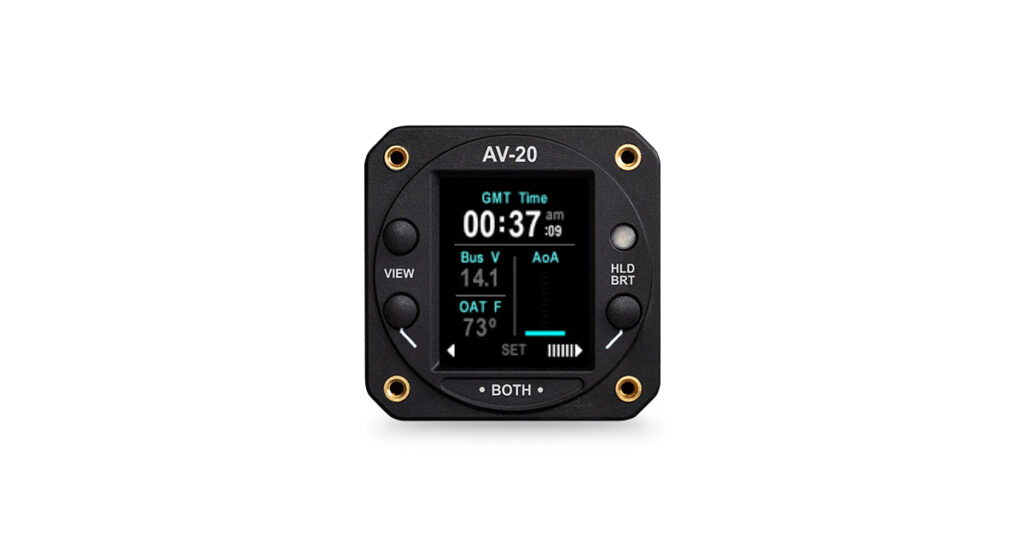Support: AV-20-S
Available for certified and experimental aircraft, the AV-20 transforms your flight panel without sacrificing simplicity.
Designed to fit in a standard 2-inch instrument slot, this powerful backup solution provides critical flight data, a built-in clock, and customizable alerts—all in a sleek, easy-to-install package.
below you’ll find everything you’ll need to install, maintain, and learn about your AV-20-S. In addition, fill out a support ticket for advanced problems or get into the details of Certification and Documentation.

Knowledge Base
Frequently Asked Questions (FAQs)
Can my installer update the software in my AV-20-S / AV-20-E to version v1.8.0?
Yes, with 3 caveats …
(1) Confirm that you have the AV-20-S software. Loading incorrect software will cause an error.
(2) Very early AV-20 units may have to be returned to uAvionix to have the software updates completed, but most devices can be done by the end user. Instructions and software download can be found in the service bulletin in the support center.
(3) For extremely old units, there may be a charge to update the software. Please log a support ticket at uAvionix.com
After the update from 1.2.0 to 1.8.0 I have a transponder page and I can't remove it.
WORKAROUND: Go into SETUP -> PAGE ENABLE->CLOCK. Disable the clock (or any other page) then re-enable it. This should make the transponder control page disappear.
With software release v1.8.0 did anything change in the way you are calculating the AoA?
Yes. We made the calculation more accurate by fusing data from additional sensors.
Where can I find the recommended update cable?
Resources & Links:
AV-20-E Service Bulletin (Software Upgrade 1.8):
AV-20-S Service Bulletin (Software Upgrade 1.8)
CostAero AV-20 Updating Cable (comes with Sabrent cable)
Sabrent USB to RS-232 Serial Adapter (SBT-USC6K)
How do I set my AOA?
Detailed setup instructions are in the Pilots Guide.
Can I disable AoA alerts?
Yes. Audible alerts could previously be disabled. Now (with software release v1.8.0), visual alerts can also be disabled. Navigation for this (and other visual alerts is: Setup Menu → Visual Alerts → Timer 1, Timer 2, AoA Limit, G-limit. Select to disable an option by pushing the right button.
Why is there a red X on the AoA now?
The red X is to be expected. Previously the AoA would indicate on the ground but would indicate incorrectly. The AoA will come alive at 25knots. The red X will be visible until 25 knots is reached. Calibration of AoA should be completed in the air.
How is a "Probeless" AoA determined?
Angle of attack is determined by comparing aircraft pitch to the actual flight path angle through the air. This is equivalent to the angle at which the wing is intercepting the body of air surrounding the aircraft – exactly the same as a probe based AoA system. Pitch is determined by a precision internal AHRS, and flight path angle is determined by a precision ADC (airspeed and vertical speed). The resulting angle is then augmented with G-Load, as determined by internal acceleration sensors.
For example, during a climb, if the pitch angle is 10 degrees up, and the aircrafts flight path through the air (forward airspeed and vertical speed) is also 10 degrees up, the equivalent AoA is 0 Degrees. However, if the flight path angle through the air is only 7 degrees, then the equivalent AoA is positive 3 degrees as the wing is no longer able to maintain full lift.
Therefore, no dedicated AoA probe is required – only internal inertial and pressure sensors (8 in total). Connection to the aircraft’s pitot static system is required.
Reference Sperry Patent #3,948,096 for additional implementation details.
Where is the pitch sync function that used to be on the attitude indicator page?
It is now in the setup menu. Note that any time the pitch sync is changed, the AoA high and low limits need to be checked, so it made sense to relocate this function to the setup pages.
My slip skid ball is not centered when level. What should I do?
In the AV-20 Setup Menu, there is a Slip Trim option that can be adjusted. See setup instructions in the Installation Manual.
The roll / bank indicator is not level on the ground. What should I do?
In the AV-20 Setup Menu, there is a Roll Trim option that can be adjusted. See setup instructions in the Installation Manual.
Why does the AV-20 display non zero true airspeed on the ground?
Non zero airspeed should not be displayed on the ground. The non-zero airspeed display is remedied with the pitot zero procedure in the Setup Menu. See setup instructions in the Installation Manual.
What is the difference between the AV-20-S and the AV-20-E?
The AV-20-E is only for experimental aircraft. The sensors are calibrated to 35,000 and it has control for the tailBeaconX.
The AV-20-S is for certified aircraft. It doesn’t have tailBeaconX control. It is certified under NORSEE.
How to adjust Brightness of the AV-20?
How do I disable popup pages (G-meter, AoA, Attitude Indicator)?
It is in the Setup Menu under MISC options.